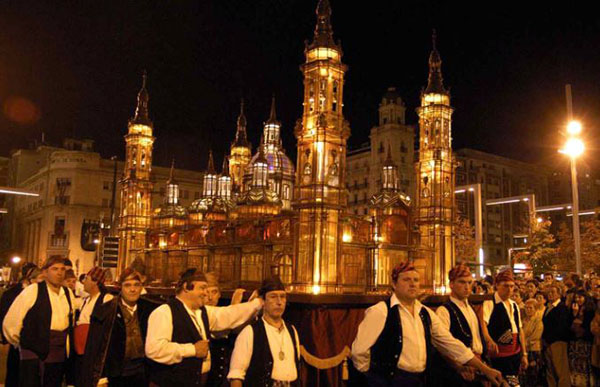The Crystal Rosary of Zaragoza is one of the most beautiful and unique religious and cultural expressions in the Catholic world. This tradition, which combines devotion to the rosary with a procession of glass lanterns, is a true spectacle of faith and art that takes place annually in the Spanish city of Zaragoza during the Fiestas del Pilar. This article delves into the history, theological relevance, and practical applications of the Crystal Rosary, offering a deep reflection on how this tradition continues to inspire and educate believers in today’s world.
History of the Crystal Rosary
The Crystal Rosary of Zaragoza originated in the 19th century when the Brotherhood of the Holy Rosary decided to create a visually impactful way to pray the rosary in community. The first procession of glass lanterns took place on October 13, 1889, and since then, it has become one of the most anticipated religious celebrations during the Fiestas del Pilar, which honor the Virgin of the Pillar, patroness of Zaragoza and all of the Hispanic world.
The glass lanterns used in the procession represent each of the mysteries of the rosary, from the joyful to the glorious mysteries, and are crafted with exceptional detail and artistry. These lanterns, illuminated from within, not only guide the rosary prayer but also serve as a display of sacred art, blending tradition, faith, and beauty.
Theological Significance of the Crystal Rosary
From a theological standpoint, the Crystal Rosary is an expression of Marian devotion, a way for believers to draw closer to the Virgin Mary and, through her, to her Son, Jesus Christ. For centuries, the Church has recommended praying the rosary as one of the most important spiritual practices, and the Crystal Rosary adds a communal and visual dimension that enhances the meditative and spiritual nature of this prayer.
The rosary, in its structure, is an invitation to meditate on the mysteries of Christ’s and the Virgin Mary’s lives. Each decade of the rosary is dedicated to a key event in the story of salvation, making this prayer a spiritual journey through the great events of the Gospel. The Crystal Rosary, as a public procession, transforms this personal meditation into a communal act of faith, where believers not only pray but also bear witness to their faith before the world.

Spiritual Meaning of the Lanterns
Each lantern in the Crystal Rosary not only represents a mystery of the rosary but also holds deep symbolic meaning. The lanterns are made of transparent glass, reminding us that Christ’s light shines in our lives and that, as Christians, we are called to reflect that light into the world. The fragility of the glass also speaks to our own human fragility and how we need God’s grace to be true lights in the darkness.
The fact that these lanterns are used in a procession is also significant. The procession is a metaphor for the Christian pilgrimage of life, where we all move forward together, guided by the light of faith, toward our ultimate destination in God. Walking together, in prayer and meditation, reminds us that we are not alone in our spiritual journey but are part of a great community of faith that stretches across the centuries and the entire world.
The Crystal Rosary in the Modern World
In today’s context, the Crystal Rosary remains a living manifestation of the Catholic faith that inspires both believers and those seeking a deeper connection with the transcendent. In a world where distractions are many and time for prayer often seems scarce, the Crystal Rosary invites us to pause, reflect, and reconnect with what truly matters: our relationship with God and with others.
The communal aspect of the Crystal Rosary is also particularly relevant in a time when individuality and isolation are growing issues in society. This tradition reminds us of the importance of community, of sharing our faith, and of supporting one another in our journey toward God. Moreover, in an increasingly secularized world, the Crystal Rosary stands as a public testimony of faith, affirming that the Catholic faith remains vibrant and relevant in modern society.
Practical Applications for Daily Life
How can readers apply the concepts behind the Crystal Rosary in their daily lives? First, praying the rosary is an accessible practice for all believers and can be a powerful way to deepen both personal and communal prayer. Taking a few minutes each day to meditate on the mysteries of the rosary can help Christians stay focused on their faith, even amid the busyness of daily life.
Additionally, the Crystal Rosary teaches us the value of beauty in our spiritual lives. Surrounding ourselves with symbols and objects that remind us of God’s presence can positively impact our spirituality. While it’s not necessary to have a glass lantern, we can make our homes, workspaces, or prayer corners reflect the light of our faith.
Finally, the communal dimension of the Crystal Rosary challenges us to be more active in our faith communities. Participating in parish events, processions, or simply praying in community can strengthen our spiritual lives and help us feel more connected to our faith and to other believers.
Conclusion
The Crystal Rosary of Zaragoza is much more than a local tradition; it is a vibrant manifestation of faith, art, and community that remains relevant in the modern world. Through its beauty and symbolism, this procession reminds us of the importance of prayer, community, and the light of Christ in our lives. By participating in this tradition, believers are called not only to pray but to live as lights of the world, reflecting God’s grace and love in everything they do.
May the Crystal Rosary inspire all of us to live our faith with greater fervor, to value the beauty of our tradition, and to walk together on the path of faith, guided by the light of Christ and the love of the Virgin Mary.






